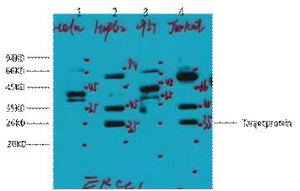TGFBR1 (Phospho Thr204) rabbit pAb
- Catalog No.:YP1676
- Applications:WB
- Reactivity:Human;Mouse;Rat
- Target:
- TGF β Receptor I
- Fields:
- >>MAPK signaling pathway;>>Cytokine-cytokine receptor interaction;>>FoxO signaling pathway;>>Endocytosis;>>Cellular senescence;>>TGF-beta signaling pathway;>>Apelin signaling pathway;>>Osteoclast differentiation;>>Hippo signaling pathway;>>Adherens junction;>>Th17 cell differentiation;>>Relaxin signaling pathway;>>AGE-RAGE signaling pathway in diabetic complications;>>Chagas disease;>>Hepatitis B;>>Human T-cell leukemia virus 1 infection;>>Pathways in cancer;>>Colorectal cancer;>>Pancreatic cancer;>>Chronic myeloid leukemia;>>Hepatocellular carcinoma;>>Gastric cancer;>>Diabetic cardiomyopathy
- Gene Name:
- TGFBR1 ALK5 SKR4
- Protein Name:
- TGFBR1 (Phospho-Thr204)
- Human Gene Id:
- 7046
- Human Swiss Prot No:
- P36897
- Mouse Gene Id:
- 21812
- Mouse Swiss Prot No:
- Q64729
- Rat Swiss Prot No:
- P80204
- Immunogen:
- Synthesized peptide derived from human TGFBR1 (Phospho-Thr204)
- Specificity:
- This antibody detects endogenous levels of TGFBR1 (Phospho-Thr204) at Human, Mouse,Rat
- Formulation:
- Liquid in PBS containing 50% glycerol, 0.5% BSA and 0.02% sodium azide.
- Source:
- Polyclonal, Rabbit,IgG
- Dilution:
- WB 1:500-2000
- Purification:
- The antibody was affinity-purified from rabbit serum by affinity-chromatography using specific immunogen.
- Concentration:
- 1 mg/ml
- Storage Stability:
- -15°C to -25°C/1 year(Do not lower than -25°C)
- Other Name:
- TGF-beta receptor type-1 (TGFR-1) (EC 2.7.11.30) (Activin A receptor type II-like protein kinase of 53kD) (Activin receptor-like kinase 5) (ALK-5) (ALK5) (Serine/threonine-protein kinase receptor R4) (SKR4) (TGF-beta type I receptor) (Transforming growth factor-beta receptor type I) (TGF-beta receptor type I) (TbetaR-I)
- Molecular Weight(Da):
- 55kD
- Background:
- The protein encoded by this gene forms a heteromeric complex with type II TGF-beta receptors when bound to TGF-beta, transducing the TGF-beta signal from the cell surface to the cytoplasm. The encoded protein is a serine/threonine protein kinase. Mutations in this gene have been associated with Loeys-Dietz aortic aneurysm syndrome (LDAS). Multiple transcript variants encoding different isoforms have been found for this gene. [provided by RefSeq, Aug 2008],
- Function:
- catalytic activity:ATP + [receptor-protein] = ADP + [receptor-protein] phosphate.,cofactor:Magnesium or manganese.,disease:Defects in TGFBR1 are the cause of aortic aneurysm familial thoracic type 5 (AAT5) [MIM:608967]. Aneurysms and dissections of the aorta usually result from degenerative changes in the aortic wall. Thoracic aortic aneurysms and dissections are primarily associated with a characteristic histologic appearance known as 'medial necrosis' in which there is degeneration and fragmentation of elastic fibers, loss of smooth muscle cells, and an accumulation of basophilic ground substance.,disease:Defects in TGFBR1 are the cause of Loeys-Dietz syndrome type 1A (LDS1A) [MIM:609192]; also known as Furlong syndrome or Loeys-Dietz aortic aneurysm syndrome (LDAS). LDS1 is an aortic aneurysm syndrome with widespread systemic involvement. The disorder is characterized by arterial tort
- Subcellular Location:
- Cell membrane ; Single-pass type I membrane protein . Cell junction, tight junction . Cell surface . Membrane raft .
- Expression:
- Found in all tissues examined, most abundant in placenta and least abundant in brain and heart. Expressed in a variety of cancer cell lines (PubMed:25893292).
- June 19-2018
- WESTERN IMMUNOBLOTTING PROTOCOL
- June 19-2018
- IMMUNOHISTOCHEMISTRY-PARAFFIN PROTOCOL
- June 19-2018
- IMMUNOFLUORESCENCE PROTOCOL
- September 08-2020
- FLOW-CYTOMEYRT-PROTOCOL
- May 20-2022
- Cell-Based ELISA│解您多样本WB检测之困扰
- July 13-2018
- CELL-BASED-ELISA-PROTOCOL-FOR-ACETYL-PROTEIN
- July 13-2018
- CELL-BASED-ELISA-PROTOCOL-FOR-PHOSPHO-PROTEIN
- July 13-2018
- Antibody-FAQs



